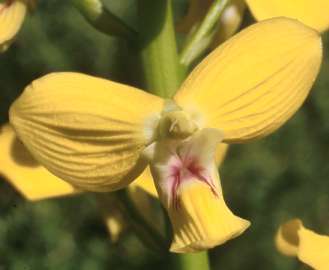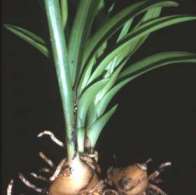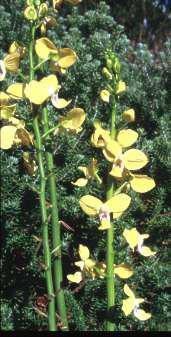Eulophia speciosa
Eulophia speciosa (R.Br. ex Lindl.) Bolus
Family: Orchidaceae
Common names:
Introduction
With its fairly large, bright yellow flowers, Eulophia speciosa, one of the most common and widespread southern African eulophias, is a rewarding pot plant that deserves to be cultivated more widely.

Description
Description
Eulophia speciosa is a terrestrial orchid with fleshy lanceolate (lance-shaped), semi-erect leaves that arise from underground corms/pseudobulbs. The lateral leafless flowering shoot is about 0.4-0.8 m tall, and bears up to 30 comparatively large flowers in a lax and unbranched raceme.

The flowers, measuring about 25-45 mm in diameter, are striking yellow and have red markings on the lip of the side lobes. Due to its very widespread occurrence in the eastern parts of southern as well as tropical Africa, the species is very variable in its structure, and some forms in southern Africa, for example two in Namibia, were originally described as different species. In the southern African region, E. speciosa flowers mostly between October and January.
Conservation Status
Status
This species is common in most parts of its distribution range in southern Africa, and is not considered as threatened or endangered. It was rated as LR-lc (= lower risk-least concern) in Golding (2002:114).
Distribution and habitat
Distribution description
Eulophia speciosa has a wide distribution range in Africa. Records have been made from the George-Knysna area of the Western Cape, through the Eastern Cape and northwards to KwaZulu-Natal, Swaziland, Mpumalanga, Limpopo, northern Botswana and northeastern Namibia. Outside southern Africa, the species is known in most countries of the central and eastern parts of Africa, from Angola and the DRC (Zaïre) to Mozambique in the east and Sudan, Ethiopia and southwestern Arabia in the north.
The plants normally grow in savanna grassland, bushland and wooded grassland, and have also been recorded from marshy coastal grassland and montane grassland.

They are found from near sea level (often exposed to salt spray) to 1 700 m in southern Africa, and up to 2 000 m in East Africa. In South Africa the plants usually grow in colonies of up to 50 plants in sandy soils or in clay. This wide-ranging species is obviously rather adaptable, and can therefore thrive under different conditions in cultivation although it is not likely to survive very severe frost.
Derivation of name and historical aspects
History
Like so many other eulophias this species was first described in the genus Lissochilus and only later transferred to Eulophia, a large pantropical genus of about 250 almost exclusively terrestrial orchids. The currently accepted generic name Eulophia is derived from Ancient Greek eu, good, and lophos, crest, which refers to the lip callus. The specific epithet speciosus means showy. Eulophia horsfallii is another species which is sometimes cultivated.
Ecology
Ecology
While we have a great deal of information on the taxonomy of Eulophia species, very little is known about their ecology as yet. Pollination is mostly also poorly understood and E. speciosa is one of the few species where it has already been examined. The flowers of this species are deceptive and offer no nectar or other reward to the pollinating insect. Pollinators are large carpenter bees ( Xylocopa sp.), which explore the flowers while they instinctively search for new food sources.
Uses
Use
Species of family Orchidaceae generally lack any major economical importance aside from their enormous horticultural potential. ( A notable exception are the various species of the genus Vanilla used extensively in the flavouring industry.)
Eulophia has great hybridizing potential but few hybrids have been registered to date. Two that involve E. speciosa as one parent species are Eulophia Jeannie Wolff (with E. streptopetala as the second parent) and Eulophia Michael Tibbs (with E. guineensis).
Parts of related Eulophia species plants have occasionally been used as food sources, for medicinal purposes and in superstition, but not Eulophia speciosa.
The showy flowers of E. speciosa have, however, been used extensively on postage stamps.

Growing Eulophia speciosa
Grow
Eulophia speciosa is comparatively easy to grow but certain rules have to be followed strictly. The plants can be grown in pots or, in a suitable climate, also planted out in garden beds, taking into account that coastal forms need higher temperatures and more watering than forms from further inland. In either case, a sunny position is required.
The author has successfully cultivated several plants of this species, both planted out in full sun in a garden bed and potted in large containers. However, as all orchids are protected by law in South Africa, the plants must not be removed from the wild without a permit, and only nursery-grown plants can be cultivated legally!
One of the most important rules of cultivation is that the plants must be kept fairly dry in the dormant period when no growth occurs — only very hardy clones can survive heavy rains in this phase, like the winter rains in the Cape Town area.
The simplest way to propagate the plants is by division of mature specimens. Also propagation from seeds in possible, but since orchid seed germination can usually only take place on the surface of a sterile medium in flasks, this form of propagation should be left to the experienced grower who has access to a modern propagation lab. The development of the protocorms ('seedlings') is very slow in Eulophia and takes about 6-12 months. Plants flower about 2-4 years after sowing.
In the growing period, the substrate should be fairly moist, but a constantly wet soil must be avoided. Plants are best transplanted and divided in the dormant season, and should be potted (or planted in garden beds) in about 2-3 cm depth in a loose mixture of equal parts of leaf mould, bark pieces, river sand and garden loam. Since the plants are to some degree dependent on their mycorrhiza, the substrate should also contain a small quantity of the soil the plants were growing in before. A layer of drainage material (coarse gravel or polystyrene chips) should be added to the bottom of the pots. Regular watering should only be started once the new shoots appear. Feeding with a liquid fertilizer is appropriate during the growing season.
Few pests cause problems in this eulophia. The tough leaves and flowering stems appear to be little damaged by garden snails. Bacterial rot of the pseudobulbs/corms due to watering during the dormant season can be a problem. If planted out in garden beds, the plants may need to be protected from mole rats that may feed on the pseudobulbs/corms.
References
- Cribb, P.J. 1989. Orchidaceae, part 3. In R.M. Polhill, Flora of tropical East Africa. Balkema, Rotterdam.
- Golding, J.S. (ed.). 2002. Southern African plant Red Data Lists. SABONET Report No. 14. National Botanical Institute, Pretoria.
- Hall, A.V. 1965. Studies of the South African species of Eulophia. Journal of South African Botany, suppl. 5.
- La Croix, I.F. & La Croix, E. 1997. African orchids in the wild and in cultivation. Timber Press, Portland, Oregon.
- La Croix, I.F. & Cribb, P.J. 1998. Orchidaceae. In G.V. Pope, Flora zambesiaca 11, 2. Flora Zambesiaca Managing Committee, London.
- Lawler, L.J. 1984. Ethnobotany of the Orchidaceae. In J. Arditti, Orchid biology: reviews and perspectives, III: 27-149. Cornell University Press, Ithaca and London.
- Linder, H.P. & Kurzweil, H. 1999. Orchids of southern Africa. Balkema, Rotterdam.
- Peter, C. 2003. Pollination in the genus Eulophia. Orchids South Africa 34: 88, 89.
- Pole Evans, I.B. 1925. Lissochilus speciosus. Flowering Plants of South Africa : t. 168.
- Stearn, W.T. 1992. Stearn's dictionary of plant names for gardeners. Cassels, London.
- Wodrich, K. 1997. Growing South African indigenous orchids. Balkema, Rotterdam.
Credits
H Kurzweil
Compton Herbarium, Kirstenbosch
November 2004
Plant Attributes:
Plant Type: Orchid
SA Distribution: Eastern Cape, KwaZulu-Natal, Limpopo, Mpumalanga, Western Cape
Soil type:
Flowering season: Early Summer
PH:
Flower colour: Yellow
Aspect: Full Sun
Gardening skill:
Special Features:
Horticultural zones









Rate this article
Article well written and informative
Rate this plant
Is this an interesting plant?
Login to add your Comment
Back to topNot registered yet? Click here to register.